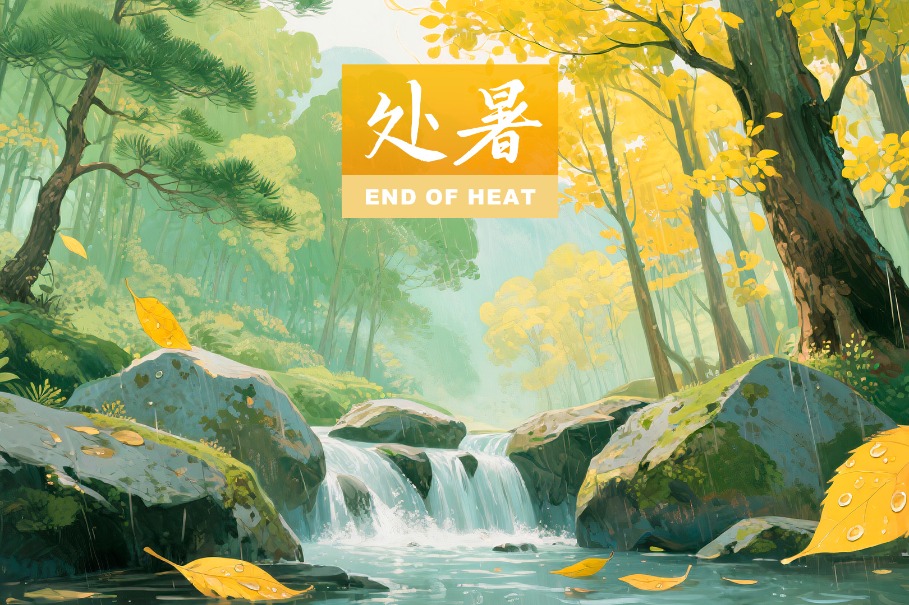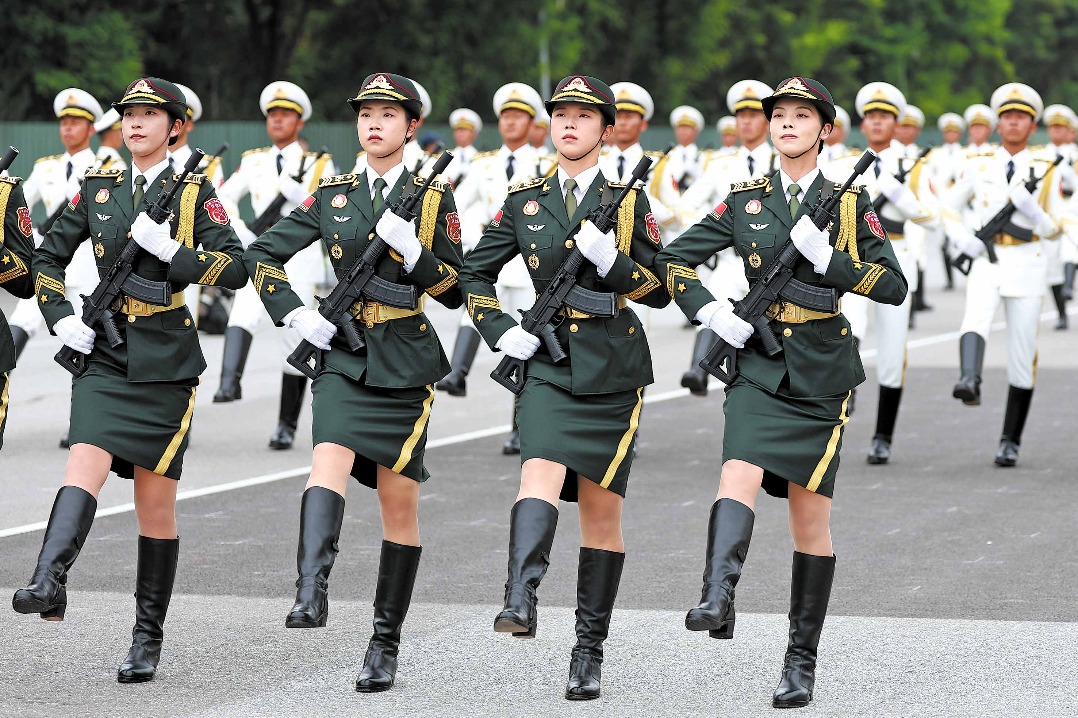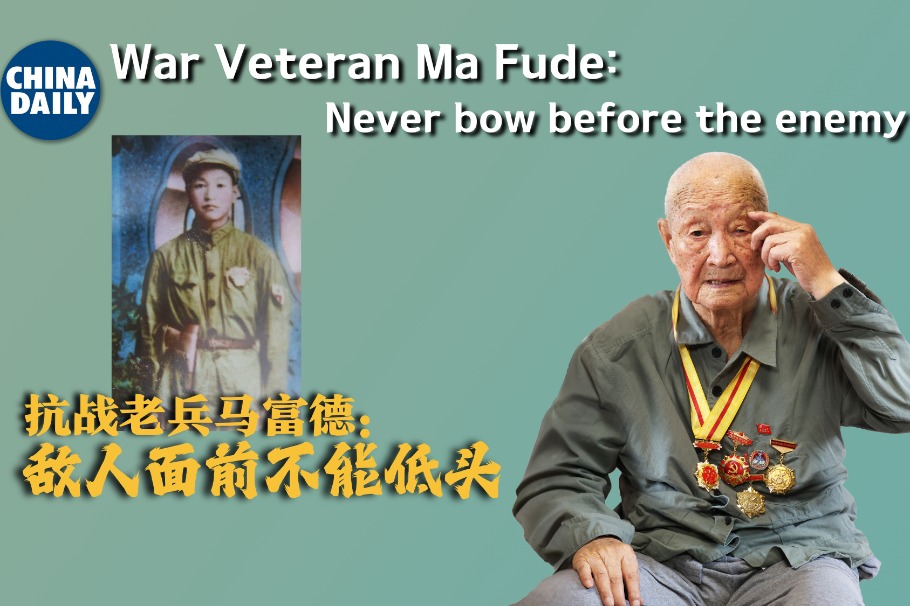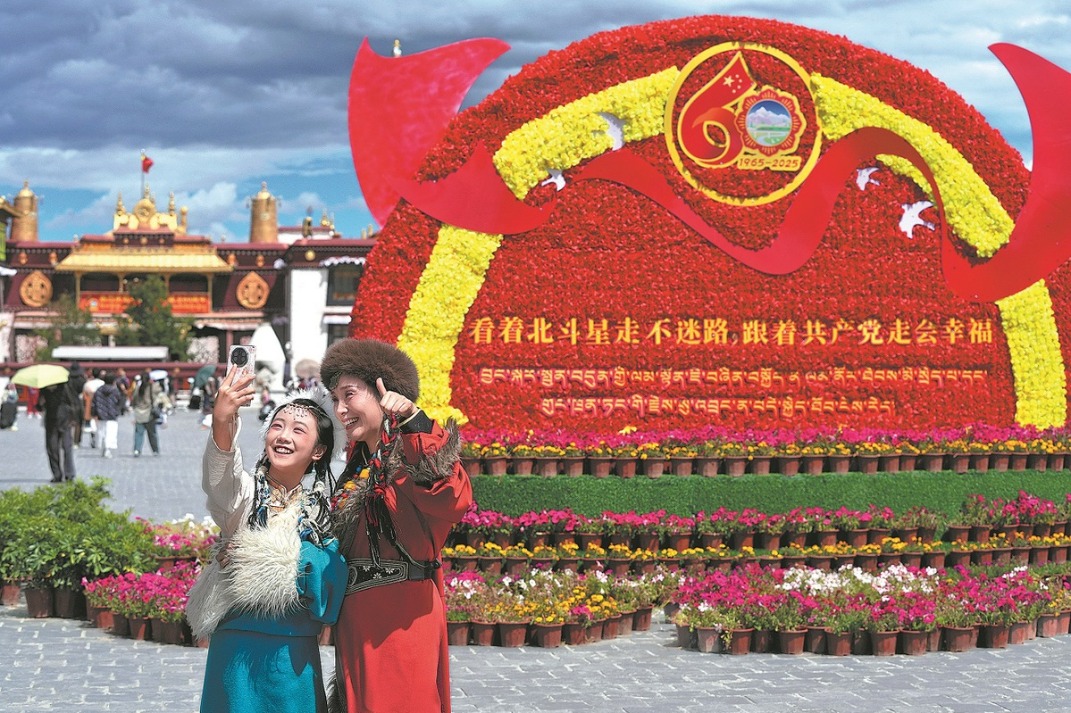Giving cotton a new frame of reference
Material gets a creative twist in the hands of an artist, Yang Feiyue reports.

In a world where cotton is mostly seen merely as a soft and fluffy material that keeps us warm, Xu Hui views it as much more. With dexterous hands and an artistic flair, the woman, in her 50s, has managed to transform cotton wadding into delicate artworks.
A big wall painting jumps into sight when one enters Xu's studio in Xi'an, Northwest China's Shaanxi province.
The images seem to pop out and have a life of their own, with meticulous details that present a small inn tucked away among a green bamboo forest where a stream flows through and children play. It lends the studio a natural touch.
When one steps in and examines the painting at close quarters, thin filaments can be spotted, unveiling the stunning craftsmanship that dates back to the beginning of the Ming Dynasty (1368-1644).
"It's all made out of cotton wadding, which is dyed in different colors through such steps as boiling and air-drying," Xu says.
Although the materials and tools used for making paintings of cotton wadding are simple, involving just cotton, glue, pigments and forceps, it is difficult in the manufacturing process, which is time-consuming, Xu says.
To produce such a painting, it is necessary to go through 16 steps, including material selection, dyeing, outlining and framing.
"Cotton wadding is particularly suitable for creating floral and feather paintings," Xu explains.
The major raw material is high-quality long-fiber cotton that is manipulated into various shapes and sizes through spreading, pulling, twisting, tearing and winding by hand.
"It takes advantage of the stretchability of the cotton, and the product can be a semi-embossed painting," she explains.
Looking around Xu's studio, one cannot help but be attracted to a variety of her art creations, ranging from glass-framed paintings to ancient-looking fans that feature natural scenery, animals and plants. They are true to life and reflect a theme of latest events.
For instance, Xu recently made a series of paintings to mark the spring equinox.
A girl running with an airborne kite, and a narrow mud track adjoining the grassland that is adorned by yellowish flowers under a light blue sky — all parts of the painting were handmade from scratch and carefully matched and pieced together.
One of her proudest works is a rabbit on a grassland with flowers.
"It was to celebrate the Year of the Rabbit, and the whole work is only 6 millimeters thick," Xu says.
She has ingeniously made the glass-framed painting look different from the front and back, in terms of the rabbit postures and plant arrangements.
Other themed works include Winter Olympics venues and medical workers fighting the pandemic.
The stunning lifelike images of her creation have recently made the news and exposed more to the charm of the craft.
Traditional and modern
In the past, people in cotton-producing areas would dye cotton batting (layers or sheets) in their spare time and use various techniques to create traditional Chinese paintings in different styles, featuring auspicious flowers, animals and totems.
These paintings were often used as gifts to celebrate birthdays and friendship or express reverence for nature and aspirations for a smooth sailing.
The art form resembles a sculpture when seen from up close but a painting in the distance. It has been widely known as a "three-dimensional painting" in the country.
Liu Zhengjun, president of the Xi'an Intangible Cultural Heritage Protection Association, says the painting uses the crop as raw material and its inspiration is derived from folk customs, with simple rural life as its subject matter, all of which makes it a valuable art.
"Xu Hui's paintings of cotton wadding have a unique style," Liu says.
"After years of exploration, she has combined traditional techniques with modern aesthetics. She also uses a unique perspective from photography, forming her own style and opening up a new realm for the painting in the realistic sense," Liu adds.
After Xu graduated from middle school in 1988, her first job was making paintings of cotton wadding at a local plant. "It was more like a random opportunity, and I was able to study the craft at the plant's arts and crafts department," she recalls.
That was when she found it fascinating that ordinary cotton could be transformed into exquisite paintings.
"I was deeply impressed," she says.
With a deep passion, Xu, then 18, began to study the techniques with Li Futang, an inheritor of the Shaanxi painting of cotton wadding.
Li studied the art from Chen Bulan, who integrated cotton wadding craft from his hometown in North China's Hebei province with classical Chinese painting in the 1970s, Xu says.
More than a decade later, Li refined the craft by taking the integration up a level, Xu says.
"At that time, the paintings were usually large in size and mostly depicted tigers, cranes and peonies," she says.
It would take a team one or two months to complete a painting of cotton wadding.
"This period was the heyday of the traditional craft," she says.
However, as time passed, the painting slowly fell short of the aesthetic tastes of modern people and was on the brink of extinction.
She realized if the painting is to survive, innovation and creative efforts should be made to adapt the historical craft to the changes of the times.
Innovative design
In 2015, Xu drew inspiration from the double-sided embroidery and applied it to paintings made of cotton wadding.
"Traditional painting methods usually require a canvas stretching at the back, forming a semi-relief form, while I used gauze in the middle as the background for actually two paintings on the front and back," she explains.
Her innovation immediately earned her the best design award in the small object category at the 2016 international quilting contest hosted by the China Fashion and Color Association.
She has also upgraded the painting technique that enables the art to jump out of a frame.
For example, to make flower works, she twisted cotton into a thread as a skeleton (branch), and then cotton-fashioned petals were added to it. "This way, the entire flower is made of cotton," she says.
It saves the trouble of cutting out the flower shape on paper first, as a traditional technique requires, and then sticking the cotton onto the paper before assembling the petals.
"The flower would appear heavy through the old-fashion way, but using the 'bone and thread' technique, it would appear more delicate and graceful," Xu says.
In 2018, Xu's beloved cotton craft was included in the intangible cultural heritage list by the authorities of Lianhu district of Xi'an.
It impelled her to pull off another innovation afterward. As a fan of blue-and-white porcelain, she experimented with the idea of using cotton to create a porcelain vase.
After she carefully studied the characteristics of porcelain ware, she applied the painting methods to create four sides of a square vase before weaving them up with a cotton thread.
It transformed the painting from two-dimensional to three-dimensional, a groundbreaking move in the Shaanxi-style cotton craft.
As her works have been sold all over the country in recent years, Xu says she has felt rising public understanding and appreciation of the cotton craft.
"I have uploaded video courses online and also taught primary school students how to make cotton craft," she says.
"Everyone likes it."
To date, Xu has integrated modern painting genres, such as oil painting, watercolor painting and colored pencil drawing, with the cotton craft, and she plans to explore a wider range of styles.
"Each generation of inheritors should breathe something new to the craft, while keeping key traditional elements," Xu says.
"It will better help the craft thrive."


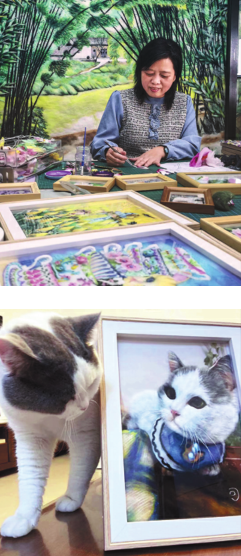

Today's Top News
- China, Japan, ROK urgently need an FTA
- From humanoids to parallel intelligence
- Shared wartime history unites nations, envoy says
- Mutual trust reaffirmed in visit
- 12 dead, 4 missing after bridge collapses in Qinghai
- Steps taken to boost domestic consumption
















